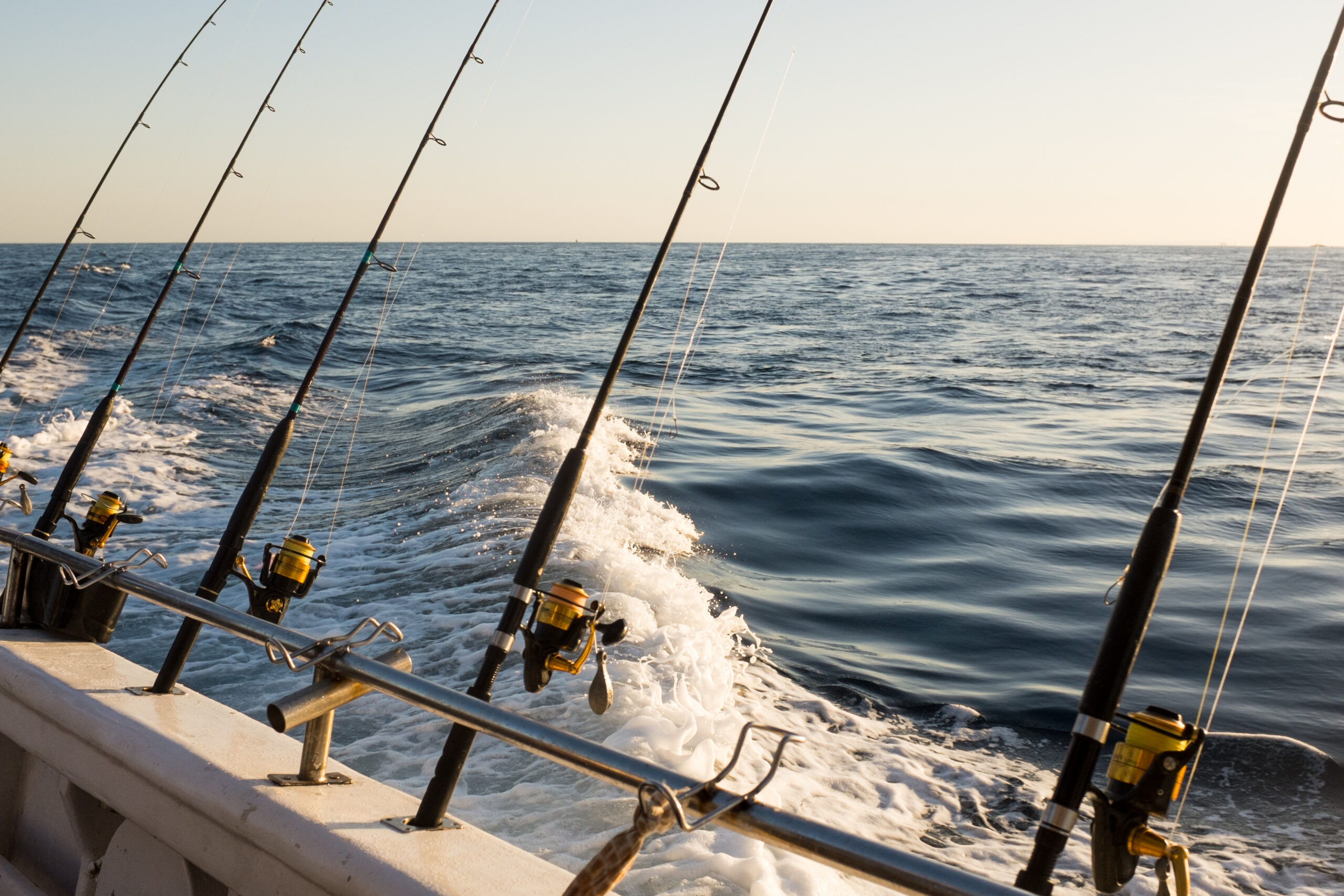
Best Rigs for Surf Fishing (To Use For Live Bait)
Living near the coast is nice for many different reasons. You have beautiful sunsets and scenery, and you are always cooler than inland during the hot months of the year. On top of that, if you are someone who enjoys fishing, hitting the beach to fish in the surf can be a great way to spend your day.
There are tons of fish in the ocean that love to live near the breaking waves because of the oxygen added to the water from the break. But fishing here requires a special rig. There are several different surf fishing rigs that might work for you, depending on what you are looking to catch.
Here are some of the best rigs for surf fishing that you can use with live bait.
Rigs For Surf Fishing with Live Bait
Fish Finder Rig
This may well be the most popular surf fishing rig. It is simple and is constructed of a leader and a hook with a barrel swivel attached to the line with a weight slide behind it. This is a great rig for larger bait because the fisherman or woman can let the fish have slack, so they have more time to fully take in the bait.

You can catch many different types of fish with this type of rig, from a bass to a small shark. All you have to do is adjust the tackle included in the rig. One thing to keep in mind is that you will have more wind resistance the longer your leader is, and this will decrease your casting range. Also, there may be some restrictions on the type of hook you use, depending on the fish.
Pros
- In a stronger current, you can slacken the line more to get a wider range of area to find a fish in
- Fish finder rigs are super simple to tie and require limited tackle
- The rig is able to be tailored in size to the type of fish you are looking to catch
Cons
- You won’t be able to cast very far
- The leader has a tendency to get twisted with the mainline when it drops to the ocean floor
Carolina Rig
This is one of those rigs that are perfect for beginners and can be used both in surf fishing as well as freshwater excursions. It is a versatile rig that can be finished with swimbaits as well as live bait. This rig consists of an egg or bullet sinker that sits above a bead and swivel. This combination will create a sound that will lure the fish in.
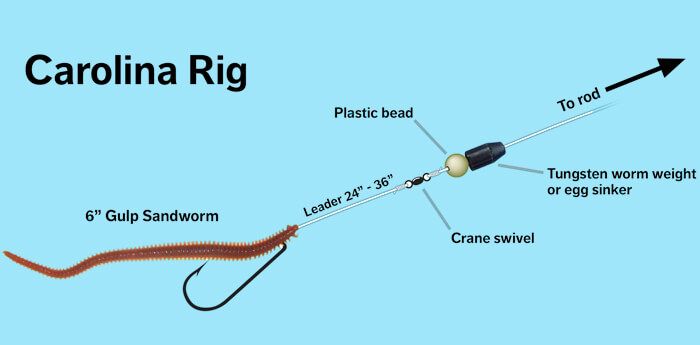
At the other end, you will place your hook and bait, which could be a live or synthetic worm, cut squid,shrimp,anchovies or mussels.Sand crabs can also be used on this rig. The size of both will depend on the type of fish you are looking to catch. The design of this rig is perfect for predatory fish that will give you a little more fight. Or you can use a lighter line and catch yourself some perch or halibut. This is one of those rigs we suggest everyone learn as it is so versatile.
Pros
- This rig allows you to map the seafloor with your sense of touch
- Is easily used in open water
- A great option for fish which typically put up more fight
Cons
- With this rig, it is easy to get your sinker stuck on rocks and other debris on the seafloor
- You will experience a slight delay in your hook-set compared to other rigs
Flapper Rig
When looking to use this rig, you have the option to choose from a 1, 2, and 3-hook variation. This choice can be made by thinking of what type of fish you are fishing for or how many fish you would like to catch. When setting this rig up, you will want to attach your hook line onto a swivel. The swivel should be placed on the main line set between a couple of beads and locking crimps.
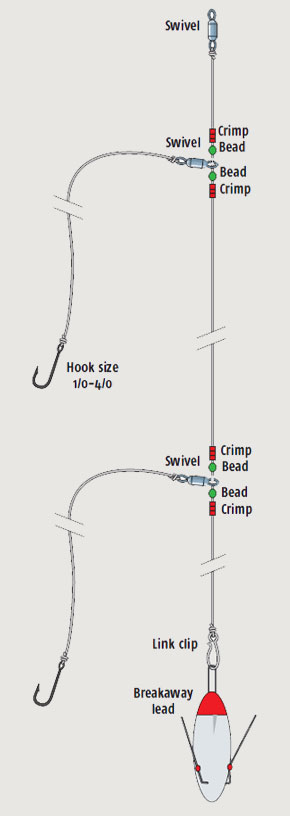
This setup allows the hook line to have more room and, therefore, a better ability to deal with twists in your line, which the movement of your bait will cause as you cast your line. It is also handy to negate the chance of twist as the line moves through the water. This type of setup is good for small to medium-sized fish that may be found in and around the break of the waves.
Pros
- The rig is capable of using a versatile number of hooks (1-3)
- Great for rough terrain as it has a lower snag rate
- More hooks mean more chance of catching a fish or two
Cons
- Flapper rig is really not a good option for long-distance casts
- Three hooks will require you to extend the snood for a deeper sinking capability
Clipped Rig
This rig is a little more intricate than the previous ones as it contains two extra pieces of tackle in its design. With the addition of the bait clip and the bait stop, you will need more time to prep this rig. The more hooks that are involved, the more link clips you will need to use. This is why you need an impact lead so that you have something to hook the lower hook to. You may also need to add a rolling swivel when dealing with the two or three hook models.
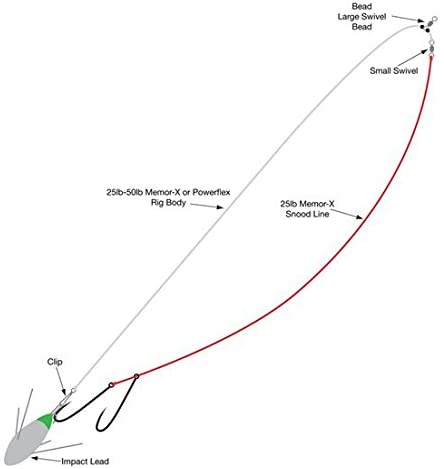
In essence, this design allows the sinker to bounce up and down when something is on the line, or you are reeling your cast back in. This reduces snag, so it is a great option for rocky fishing areas or even mixed areas. You are also directly connected to the hook, which means you have more control over the fish. Though it is really only great for long-distance casting, the amount of that distance can be adjusted through the use of sinkers and hooks.
Pros
- Rig design helps reduce the change of snagging
- Aerodynamic set up helps increase your casting range capability
- The use of impact leaders helps keep the bait in place even with a strong tide
Cons
- Not a great option for close casting
- Set up is more intricate than some of the other rigs
DropperLoop Rig
In this rig, the swivel (cascade style) is attached to the mainline closer to the hook than other rigs. This makes the bait stick tight, creates a loop in the rig, and gives it its name. The loop is between the rolling swivel used for the link lip and the cascade swivel. You can hook up multiple hooks to this rig, which comes in three variations: the 1-up, 1-down, and 2-up/1-down.
It is a more intricate rig for sure, and so it is a better fit for those that are more experienced. The compact nature of this makes it a better choice for certain surf fishers than a clipped model. Other than that, we would suggest this for long-distance casting. It is a more compact design, but it still may be too long for certain situations. This rig is good for enticing multiple fish and can be used for many different sizes of fish, depending on how many hooks you use.
Pros
- A good alternative to a clipped rig as it is shorter
- Great for long-distance casting
- Can be made in variable layouts for more versatile use
Cons
- This is a more intricate design, so it is not for beginners
- The length of the rig may be too long for some situations
Hi-Low Rig
If you are looking to increase your odds of catching a fish, then this rig is a great option. In this rig, the weight is below the hooks, and this design lets the line be able to use multiple hooks and various types of bait at the same time. But it also means you have a fixed weight which creates a need for a quick set. If you don’t, then you may lose the bait and, therefore, the fish.
For this reason, the best live bait to use with this rig is a smaller and softer option like worms. This rig allows for catching multiple fish simultaneously and leads to not having your bait stolen as much. Once you have figured out the tying of the rig, you will also experience fewer tangles, and depending on the hook and weight, you will find you will be able to catch a wide variety of fish with this rig.
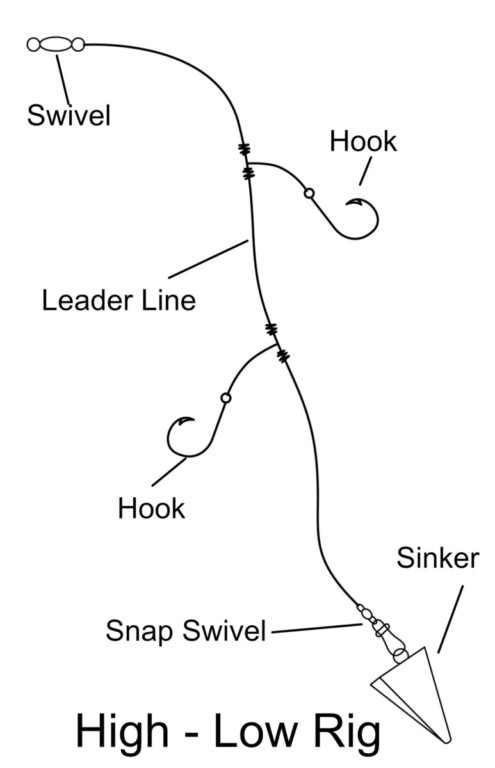
Pros
- The multiple hooks will allow you to use different types of bait on the same cast
- Having two different hooks means that if you lose one, you can still catch a fish
- The different levels of hooks allow for fishing in different depths
Cons
- The rig is complicated; therefore, it will take more time to tie
- Line may experience more pressure from strong currents and movement
Sabiki Rig
This rig was first made popular by fishermen in Asia and is also known as a flasher rig. It is crafted using multiple flies that are fastened to a flat-ended hook. This is typically a spade shape and reflects the light so that it increases the hook’s visibility to the fish. The fly drifts out from the line, and this helps decrease tangles. However, this rig has been altered a bit by some to use live bait instead of the flies. You attach the sinker to the bottom of the rig and add a spoon or jig.
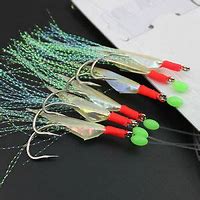
This rig is a pretty popular option for surf fishermen and women who like to cast off piers. It is typically looked at as a mackerel rig but can be used to catch a wide variety of fish. Like many of the other rigs, its multiple hooks guarantee that you will catch more fish than normal. It is also easier to set up than other rigs like the loop rig, making it a good intermediate option.
Pros
- Rig design keeps the bait alive in the water
- Crafted ideally to catch small to medium fish
- Designed with multiple flies for a variety of fish options
- Good for multiple depths when it comes to fishing spots.
Cons
- When setting a hook, you need to be more gentle than other rigs
- May need more than one person to bring in the fish
Whole Mullet Rig
Not as popular as other rigs, this rig uses live mullet as the bait portion of the setup. It is very popular in Central and South America. It is typically used when you want to catch large fish like Bluefish. You attach the weight above your hook, and this should be equal to the weight of the mullet you will be using as bait. The hook will be slid through the tail right below the spine. This will ensure they keep moving on the hook so they can attract the fish’s attention.
You will also want to attach a Styrofoam float so that you can keep the line off the seafloor so other animals can’t swim off with our bait. This setup works well if you are fishing for fish that like to strike for the rear. Of course, before choosing this rig, make sure you can handle using live bait and leave them alive. If you’re not, maybe just sticking with one of the rig options we have looked at above is the right choice for you.
Pros
- Uses live bait, which improves the odds of catching fish
- The weight keeps the live bait swimming in the strike zone
- Rig is very quick and easy to put together
Cons
- You will have to be okay with using larger live bait
- If you don’t set the weight right, crabs may run off with your bait
Final Thoughts
Surf fishing can be a great way to spend an afternoon. So if it’s something you are thinking of taking up, knowing the right rig to use could help you be successful in your endeavor. We have covered some of the best options here and we hope that the look at surf fishing rigs above helped you with your decision-making process.
